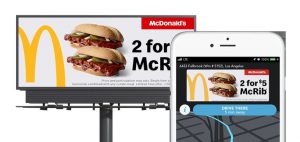Geofencing is a marvelous tool for location-based campaigns. You may have heard of it and know it’s commonly used in campaigns targeted at smartphone users. While digital signage might not come to mind immediately when someone mentions geofencing, there is a certain magic that happens between these two components.
You might be wondering how they work together, or even how location matters for a display! If that is the case, read more on location-based advertising and its relevance for digital signage. There, you will see just how important location and context is when it comes to any type of advertising, including one done through the network of digital signage. With the power and value of location behind us, we take a closer look at geofencing. It is part of the many tools and methods available for location-based advertising. We’ll answer some of the most common questions on the topic. Also, we’ll reveal why and how geofencing is important for your next digital signage campaign!
What is geofencing?
This compound term made up of the words geo and fence might not sound so unusual to most, but its meaning certainly isn’t as widely understood. Geofencing refers to a virtual boundary which encompasses a certain physical location. Geofencing isn’t restricted by the size of an area and can be as large as a neighborhood or city, or just apply to the doorstep of your business. It usually relies on GPS as the most accurate way of establishing the specified boundary points. Typically, as mentioned, the purpose of geofencing is to send content to smartphone users when they enter –or leave for that matter– a specific location.
One example you may have experienced yourself is entering the coverage area of a different network provider. Particularly, when crossing a country or state border, you often get a text message welcoming you and informing you of the provider’s rates and offers. Study the full definition of geofencing to grasp it wholly.
Is geofencing relevant to digital signage?
While it’s mainly used for sending content to smartphone users, geofencing can indeed be applied to digital signage displays! For geofencing to make any sense at all, these displays must be in motion to cross from one geofence location to another. Thus, geofencing is most relevant to displays used in transportation or mounted on any type of moving vehicle. As the vehicle crosses the geofence and enters a new location, specific content can be displayed.
A traveler appreciates information about the local area they’ve never visited before. Using geofencing like this enables the display of ads, directions and any type of information relevant to the location.
What about digital displays that aren’t in motion?
Although geofencing realizes most of its potential with displays in motion, it doesn’t mean it can’t be used under different circumstances. Displays fixed in one place can also utilize geofencing, but in a somewhat different way. They obviously can’t change the content displayed based on location: their location never changes. However, they can complement the aforementioned use of geofencing which reaches out to the smartphones of consumers.
McDonald’s is a great example of this complementary use. Their campaign involved the use of billboards and Waze, a community-based GPS navigation app. They used over 300 billboards with geofencing technology which interacted with Waze users nearby. Whenever a user’s car would stop for a few seconds, they’d get a pop-up ad which matched the ad displayed on nearby billboards. The ad offered navigation to the nearby restaurant, and over 8,400 people accepted it. Overall, the campaign reached 1.9 million unique consumers across a time-period of eight weeks.
Should you embrace geofencing?
Through the answers and examples above, you now understand how it works. So let’s answer a question subsequently asked by business owners: “Should I invest in geofencing?”
The answer to this question is often subjective, depending on your business situation. If you have displays in motion, you should most definitely use it. There is no question about it! The mobility itself is the perfect opportunity to utilize the maximum potential of geofencing. Digital signage software like OnSign TV provides you with the ability to do that, quite easily too!
You could try it even if you only have displays fixed in one location, if you’re up for experimenting. But it’s safe to say that, while highly powerful, geofencing shouldn’t be at the very top of your priority list in this case. Instead, if your business isn’t at the point where it can invest in such a feature like McDonald’s did, it’s better to focus on location-based advertising overall and display content relevant to the location where each of your displays is set in. As the location of your display won’t change, if you design your content properly and make it location-based, it will always hit the spot.








